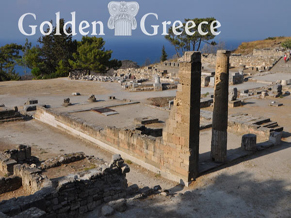
The area of Kameiros extends on the wilder and windier northwest side of the island near the cape of Agios Minas (the ancient Mylantio) at the foothills of Mount Akramytis. During prehistoric times, the Mylantian gods were worshiped here who taught people about milling and kneading. The archaeological physiognomy of the area also includes Mycenaean cemeteries in Kalavarda, west of Kamiros. Finds from the Geometric period (8th century BC) indicate the existence of a temple dedicated to Athena on the acropolis. The first great earthquake of 226 BC. destroyed the classical city and the temple of Athena Kamirados. The Hellenistic city was built according to the Hippodamian system in three levels.
At the top of the hill is the acropolis with the temple of Athena and the stoa. In the middle of the hill the settlement spreads out and lower rises the Hellenistic temple, the Doric fountain, the market and the precinct of the altars. The wider space was decorated, as in every classical and Hellenistic city, with a multitude of votive offerings, such as columns and platforms with statues. But the terrible earthquake of 142 BC. destroyed the city of Kamiro a second time.
Archaeological site of Kamiros:
monumental staircase between the market and the precinct of the altars leading to the center of the settlement, foundations of buildings and temples and clay vessels, which seem to have been mass-produced in antiquity. According to one version, the archaic Municipality of Kattavea, which belonged to the Lindian state, was located here.
Knight's fortress (Apollona):
Ruins of a knight's fortress are preserved. Based on a knightly decree of M. Magistro Orsini (1474); it could also accommodate the population from neighboring Laerma.
Archaeological findings (Kalavarda):
Archaic and classical tombs with valuable offerings.
Knight's fortress (Soroni):
Ruined today for the most part.
Editor: Fotini Anastasopoulou